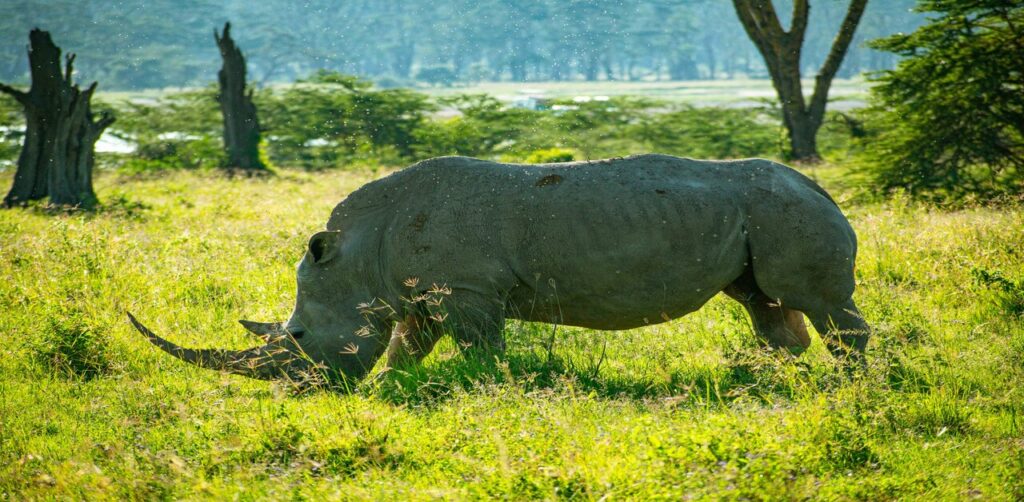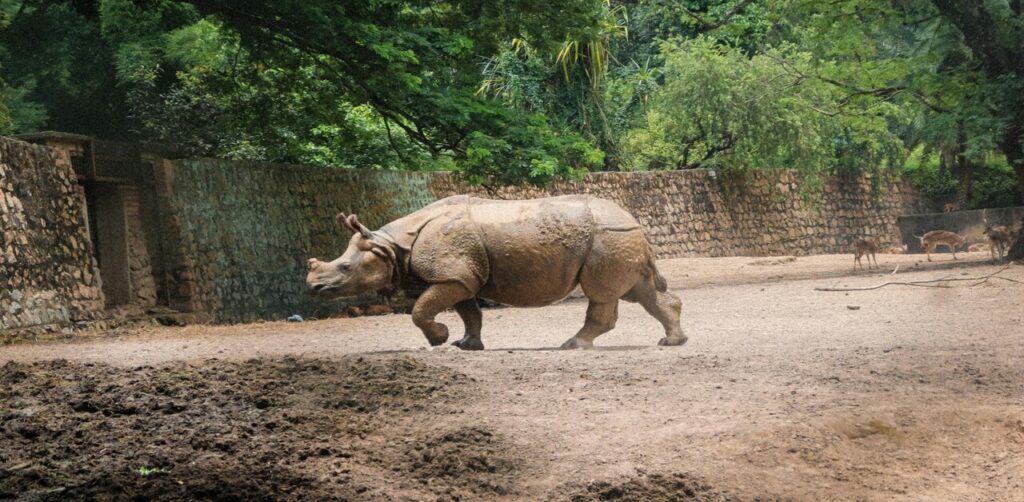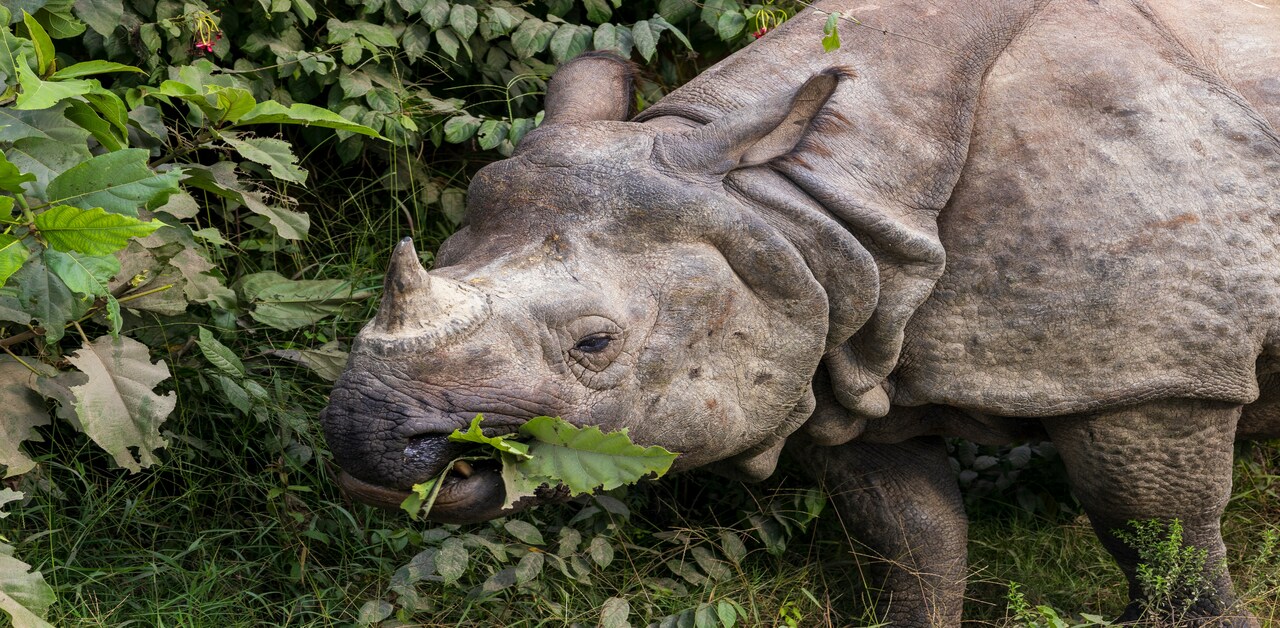The Indian one-horned rhinoceros (Rhinoceros unicornis), also called the Greater one-horned rhino, is one of the most well-known and magnificent animals found in India.
Having a thick, armor-like skin, a big size, and a solitary horn, this king of the forest is both ecologically and culturally important.
Also known as the one-horned rhino, the species was once found freely throughout the northern region of the Indian subcontinent; however, it is now mostly found in protected regions.
Although a horned rhino is currently a story of successful conservation, there are still a lot of challenges that the species has to deal with.
Table of Contents
About the Greater One-Horn Rhino
Scientific Name: Rhinoceros unicornis
Common name: Indian rhinoceros
Family: Rhinocerotidae
Distinct feature: one black horn (20-60 cm), and the skin is grey-brown with folds, which makes the skin look armor-like.
Feed: Primarily grazers. Feed on grasses, leaves, fruits, and aquatic plants.
The Greater one-horned rhino is the biggest among all the species of rhinoceros, with an adult male weighing as much as 2,200-3,000 kilograms, which is comparatively less when it comes to female rhinoceroses.
The only thing that makes this rhino stand out is its single, black horn, which can be as long as 25 inches (60 cm).
The Indian rhino has a completely keratinous horn, making it similar to human nails, unlike the African rhino.
The animal has thick grey-brown skin covering the body and creating folds, due to which the animal looks as if it has plated armor.
These creases are not merely ornamental since they serve several purposes, such as control of body temperature and protection in a battle.
Rhinos are, in general, very solitary creatures, except when breeding and when the mothers are rearing calves.
They are quiet and shy, but when they feel threatened or provoked, they can become aggressive.
If you want to buy a bag at an affordable price, then you can click here.

Distribution and Habitat
The greater one-horned rhino was once found in India, Nepal, Bhutan, Bangladesh, and Pakistan. But because of habitat loss, poaching, and encroachment by human beings, their population was drastically reduced in the 20th century.
They are currently concentrated in India’s Assam, West Bengal, and a portion of Uttar Pradesh. The largest such population is found in the Kaziranga National Park in Assam (more than 2,600 rhinos), thus making it the largest population of the species worldwide.
Note: Kaziranga alone holds over 70% of the global population of this species.
Important Other Habitats:
Pobitora Wildlife Sanctuary (Assam)
Manas (Assam)
Jaldapara National Park (West Bengal)
Dudhwa National Park (Uttar Pradesh)
Assam’s Orang National Park.
Such areas are described by the alluvial floodplains, tall grasslands, swamps, and riverine forests, which are ideal habitats for rhinos.
Conservation Status
Global Context—Five Rhino Species
Species—Region—IUCN Status
1. Black Rhino—Africa—Critically Endangered
2. White Rhino—Africa—Near Threatened
3. One-Horned Rhino—South Asia—Vulnerable
4. Javan Rhino—Southeast Asia—Critically Endangered
5. Sumatran Rhino—Southeast Asia—Critically Endangered
Protection Status
Organization—Status
IUCN Red List—Vulnerable
CITES – Appendix I
Wildlife Protection Act, 1972—Schedule

Feed
The Greater One-Horn Rhino is a herbivorous animal that prefers grasses, leaves, shrubs, fruits, and water plants. They rest at the hottest hour of the day and feed early in the morning or late in the afternoon.
Sometimes, they wallow in muddy ponds to cool off and keep insects away. They are strong swimmers and have been known to be partially underwater in other water bodies with only their ears and nostrils sticking out of the water.
Although rhinos are large, they can run short distances at a high speed of 40 km/h when frightened.
Cultural and Ecological Significance
The Greater One-Horn Rhino has a strong connection with the cultural and natural heritage of India. In several regions of Assam, it is viewed as an epitome of fierce force and toughness.
The Greater One-Horn Rhino also exists in folk stories, tribal art, and even political symbols.
Rhinos are important in their ecosystems ecologically. They are mega-herbivores, which improves the landscape through grazing, keeping grasslands healthy, and helping other species.
Their manure is high in nutrients and helps to spread the seeds and also nurture the soil.
Major Threats
Because of the effort made on their conservation, the population of the greater one-horned rhino has grown considerably, but they remain listed in the IUCN Red List as Vulnerable.
1. Poaching
The horn of the Greater One-Horn Rhino is prized in black markets of wildlife, where it is mistakenly believed to be medicinal in Asian parts of the world. Poaching is an issue despite the harsh laws.
2. Habitat Loss
Habitat destruction and fragmentation have been very high due to urbanization, farming, and industrialization. The habitat of the rhinos is also threatened by floods that partly occur because of climate change and the building of dams in Assam.
3. Human-Wildlife Conflict
When the human population encircles the protected regions, rhinos occasionally invade farms, which causes tension with the natives. This may cause injury or death to the rhinos and human beings.
4. Climate Change
The unpredictable monsoons and floods, particularly in the low-lying national parks in Assam, pose a danger to rhinos as well as to the food supplies. An increase in water levels is likely to cause the displacement or death of rhinos.

Conservation Efforts
Government and Legal Programs
Project Rhino: Ruled by the Assam government to preserve the habitats of rhinos
Indian Rhino Vision 2020 (IRV 2020):
It was launched in 2005.
The intention is to boost the population of rhinos in Assam to 3,000 by 2020 within 7 protected areas.
Implemented by: Assam Forest Department, WWF-India, IRF, and Bodo Territorial Council.
The attempts of India to save the Greater One-Horn Rhino have been great. Since its inception in 1905, when only 75 people were recorded, its population has grown to more than 3,700 today in both India and Nepal.
Some of the important conservation actions are as follows:
1. Anti-poaching Laws: Forest guards and surveillance devices such as drones and camera traps are deployed to track the movements of rhinos and prevent poaching.
2. Translocation Projects: To stabilize the populations and to diversify rhinos, they have been moved out of the high-density parks, such as Kaziranga, to the parks of lower density, such as Manas.
3. Participation of Community: Eco-tourism and awareness programs involve the local communities, who get to comprehend the importance of saving the rhinos.
4. International Cooperation: India, Nepal, and other South Asian neighbors work together to protect migration routes and exchange conservation measures.
The Greater one-horned rhino is important in the conservation of wildlife in India through national parks and wildlife sanctuaries. The best place for Greater one-horned rhino conservation is the Kaziranga National Park, which is a UNESCO World Heritage Site.
Due to its tight security and frequent patrols, it is a role model in the successful management of wildlife.
Manas National Park is a park that was completely ruined by insurgency and poaching, and now is seeing a second life with the reintroduction of Greater one-horned rhino.
These parks are also important tourist attractions, a factor that provides economic stimulus to the areas and finances environmentally related activities.
Some Sustainable Efforts
Although it is encouraging to know that progress is being made, the path is not easy. Conservationists are demanding a multipronged attack, involving.
1. Increase in Protected Areas: To provide the Greater one-horned rhino with safe passageways through which they can move, it is necessary to increase the number of protected areas.
2. Technology Integration: The implementation of GPS tracking, drones, and AI in the process of monitoring rhinos and spotting poachers can help strengthen it.
3. Community-Based Conservation: Local people can be converted into rhino protectors when local communities are educated and provided with sustainable lifestyles.
4. Better Enforcement: Closing the illegal wildlife trade networks is key to keeping poaching down.

Conclusion
The Greater One-Horned Rhino is not simply a species of wildlife; it is a symbol of ecological wealth and strength in India. It is a success story of what can be done with dedicated conservation efforts in spite of insurmountable odds.
Still, we should not be complacent. We still need to aid, enlighten, and act in favor of the horned rhino.
Conserving this magnificent animal is not only a guarantee to preserve a certain type of animal, but also to maintain whole systems of life and leave something for future generations as well.
In a world that is rapidly changing, the Greater one-horned rhino serves as a reminder of the need for balance between humans and nature.
We can play our role in making sure that the greater one-horned rhino survives in the grasslands of India for many more centuries.

